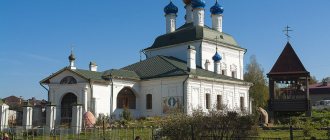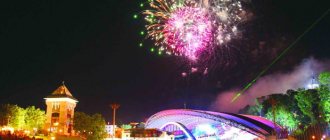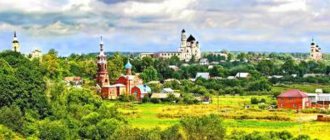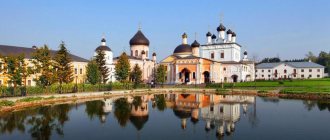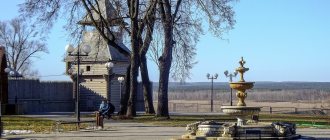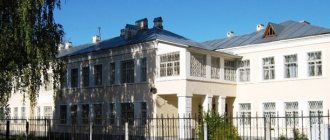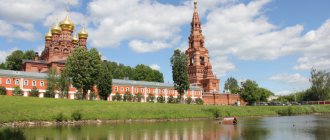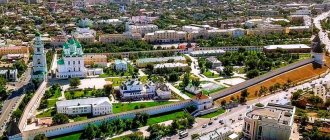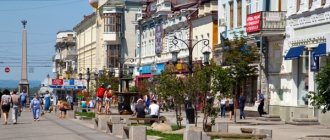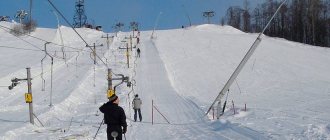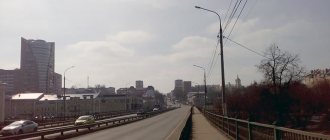Kozelsk, also known as the “evil city,” received its nickname in 1238 from Batu Khan, who lost almost half of his army and three sons here. Then only 300 Kozel residents held back the ten thousand Mongol army for almost two months. Due to its location, the city was constantly at the center of military operations, for which in 2009 it was awarded the title “City of Military Glory.”
Leo Tolstoy visited the city three times. Here he collected proverbs and sayings for “The Power of Darkness”, wrote “Hadji Murat” and his last article “The Real Remedy”. Ivan Turgenev created “The Dog” in Kozelsk, and Fyodor Dostoevsky described the city itself and its inhabitants in “The Brothers Karamazov”. “The Evil City” was also visited by Mikhail Prishvin, Dmitry Furmanov, Nikolai Gogol, Alexander Pushkin. Bulat Okudzhava was a teacher at one of the schools near Kozelsk, and later wrote his first album here.
Parks, waterfalls, caves, estates - all the most interesting things you can go to from Kozelsk, in this review of attractions in the Kaluga region.
Important information about Kozelsk
Kozelsk is located in a picturesque corner on the banks of the Zhizdra River. It is separated from the regional center - Kaluga by only 72 km.
If you look into its history, it turns out that it appeared even before Moscow. True, only for one year.
We heard about the events that brought historical glory to the city in school lessons, where we were told about the invasion of Batu in 1238. Returning from another campaign, the khan decided to take a small town that came along the way. But a surprise awaited him. Residents of Kozelsk defended themselves for 7 weeks. The facts speak about their heroism:
- About 4,000 Mongols were killed on the battlefield. Among them were close relatives and friends of Batu.
- Even cities such as Vladimir and Ryazan could not resist for more than 5 and 10 days.
The Khan's revenge was cruel - the remaining population was destroyed. They did not spare the elderly, women or children. And Prince Vasily of Kozel (at the age of 12) was ordered to be drowned in blood. Batu was so angry that he ordered the name of Kozelsk not to be mentioned and called it “Evil City.”
Thanks to this event, the city was awarded the title “City of Military Glory” in 2009. Episodes of the Great Patriotic War also affected this decision.
In memory of the defenders of the city, a monument was erected on the Heroes of Kozelsk Square
Nearby there is a long wall with drawings related to the history of the city. A commemorative 10-ruble coin, issued in 2013 in the “Cities of Military Glory” series, is dedicated to Kozelsk.
In recent years, there have been disputes between historians and archaeologists about the presence of ancient settlements on the modern territory of the city.
After excavations in 1992, archaeologists suggested that the city (XI-XIII centuries) was located in a different place, since no traces of ancient Russian times were found. However, employees of the Kaluga Regional Museum and workers of the Ugra National Park carried out excavations covering a larger area. They were able to provide evidence that settlements of Vyatichi from the squad of Yuri Dolgoruky lived on the banks of the Zhizdra River.
These warriors gave the future city such an unusual name. There are 2 versions:
- The most common hypothesis is that it is associated with the words “goats” (construction devices) and “forest”. In ancient times the city was called Kozelesk.
- But there is another interpretation - the basis is the roots of “Khazar” and “Elets” (forest). Historians suggest that the Vyatichi indicated their successful conquest of lands from the Khazars.
Over the next 2 centuries, Kozelsk belonged to the Karachev principality, existed as a separate Kozelsky fief, and belonged to the Lithuanians and Russian princes. Survived repeated fires.
Only in 1494 did it finally return to Rus'. During the time of Ivan the Terrible, changes took place to strengthen Kozelsk:
- a new fortress wall was built;
- Construction work was carried out within the city boundaries.
The peak of his fame is the 16th century. The population increased to 15,000 people. The number of churches reached 40. It was larger than Kaluga.
However, after the events of the Time of Troubles, Kozelsk was unable to recover and gradually turned into an ordinary county town. The struggle for power between the boyars and the royal families, the aggressive campaigns of Ivan the Terrible, which destroyed the economy, and the consequences of the oprichnina had an impact.
In the 18th-19th centuries, crafts and industry almost did not develop in Kozelsk. The main occupation of the residents is trade with the cities of Russia and Ukraine. They went to fairs in nearby areas.
During the Great Patriotic War the city suffered greatly. It had to be restored almost from scratch.
Currently, as before, there are few factories in it: brick, mechanical, glass. The life of a significant part of the population is connected with the army, thanks to the 28th Guards Missile Division of the Strategic Missile Forces located there.
The city during the Second World War
On June 22, 1941, the Great Patriotic War began. The men of the city went to the front. Only children, old people and women remained in Kozelsk. The fighting was approaching the city. First, refugees from the western regions of the country came in a stream through Kozelsk, then defeated, retreating units emerging from encirclement. And on October 8, 1941, German troops of Army Group Center entered the city. However, the occupation did not last long. Already on December 28, 1941, as a result of the Belevsko-Kozel operation, the city was liberated by the cavalry group of General Belov.
Perhaps due to the fact that during this short period the city was occupied only by army units performing specific combat missions, during the eighty days of occupation Kozelsk did not experience the atrocities that the Nazis committed in other territories they occupied.
Modern city center
Modern Kozelsk remains a quiet, calm, tidy place. Most of the houses in the center are wooden, one-story. A walk along the central street, Bolshaya Sovetskaya, will allow you to see many of the city’s sights.
It is from this street that travelers who come from Kaluga-Moscow begin their acquaintance with Kozelsk. It contains city museums, parks, 3 of the 6 surviving churches, and Heroes of Kozelsk Square. We’ll tell you about these remarkable places separately, but for now – a short walk.
Among the merchant buildings, the solid mansion of the merchant Bryuzgin, the former owner of a sailing factory, attracts attention. It was built in the classicism style of the early 19th century. In those days it was considered the best house in the city.
Chkalova Street runs perpendicular to Bolshaya Sovetskaya Street, leading to the station. The center of the city is considered to be the place where they intersect. Arriving buses from Moscow and Kaluga, Optina Pustyn stop at this place.
Kozelsk railway station can be called both an architectural and historical landmark
It is famous for the visits of Grand Duchess Elizabeth Feodorovna, Sergius Nilus and Leo Tolstoy, who visited it a few days before his death. Inside the station there are memorial plaques in honor of famous historical figures who visited it.
Kozelsky stone cross
This stone cross is the oldest monument in the Kaluga region. According to historians, its creation dates back to the 5th century. According to experts, this stone was a pagan idol of the Vyatichi who lived in these places. Initially, the cross had different shapes and looked more like a woman, due to which ancient people identified it with the image of their goddess. With the advent of Christianity on Russian soil, the stone was hewn, giving it the shape of a cross. After the invasion of Batu Khan, the surviving residents of the city placed this stone on the mass grave of those killed during the siege of the city. During the Soviet Union, the stone was repeatedly moved and removed from view. As a result, it was placed in the storerooms of the local history museum, where it remains to this day. A copy of it is installed on the Heroes Memorial Square.
City Park
The final destination of a walk through the center is the city park, located on the steep bank of the Zhizdra. Interesting places in the park:
- Revived remains of the fortress wall with a model of the tower of the ancient Kremlin. Anyone can climb the tower.
- The observation deck is a good place for a memorable photo shoot, allowing you to view Optina Pustyn, the surrounding landscapes, and remote areas of the city. From here you could see the conquerors going to storm the fortress.
- Updated fountain.
City Park
Park location: Bolshaya Sovetskaya street, 6.
Victory Day May 9
On the main street:
Army hand-to-hand combat group:
Ready for the Victory Day Parade!
Victory Day holiday May 9:
Watch a small part of the holiday:
Assumption Cathedral
It is located near the park.
The legend says that in 1238 there was a wooden church on its site during the reign of the young Prince Vasily Kozelsky. The defenders of the city who had taken refuge in it were burned alive. They preferred death, but did not surrender to the Tatar-Mongol conquerors.
The date of construction of the temple is considered to be 1824. But some documents indicate the date - 1770. Later it was only rebuilt. Confirmation of the fact of its early existence was found in historical papers:
- An image of the Assumption Church made of stone existed on the map of the atlas of the Kaluga governorship in 1782.
- The description of the historian Kavelin indicates that the temple managed to survive the fire of 1777, and extensions were created in 1824.
At the beginning of the twentieth century, a choir of monks from Optina Hermitage was created in the Assumption Church.
After closing, the cathedral was rebuilt as a drama theater. During the war, the Germans placed a stable in it. Then the House of Culture visited there. Gradually the building collapsed and acquired a dilapidated appearance.
Since 2001, they began to restore it.
Now it is the main temple in the city
Address: Bolshaya Sovetskaya street, 8.
Population[ | ]
| Population | ||||||||
| 1857[9] | 1859[10] | 1868[11] | 1897[12] | 1913[13] | 1920[14] | 1923[15] | 1926[16] | 1931[17] |
| 7953 | ↘7530 | ↘7325 | ↘5619 | ↗6358 | ↘3957 | ↗4911 | ↗5707 | ↗5793 |
| 1939[18] | 1959[19] | 1970[20] | 1979[21] | 1989[22] | 1992[23] | 1994[23] | 1996[23] | 1998[23] |
| ↗8182 | ↗12 114 | ↗13 026 | ↗19 789 | ↘19 735 | ↗19 900 | ↗20 200 | ↗20 600 | ↗20 800 |
| 2001[23] | 2002[24] | 2003[23] | 2005[23] | 2006[23] | 2007[23] | 2009[25] | 2010[26] | 2011[23] |
| →20 800 | ↘19 907 | ↘19 900 | ↘19 500 | ↘19 300 | ↘19 100 | ↘18 500 | ↘18 245 | ↘18 200 |
| 2012[27] | 2013[28] | 2014[29] | 2015[30] | 2016[31] | 2017[32] | 2018[33] | 2019[34] | 2020[35] |
| ↘17 871 | ↘17 312 | ↘16 694 | ↘16 273 | ↘16 045 | ↗16 370 | ↗16 443 | ↘16 389 | ↗16 427 |
| 2021[1] | ||||||||
| ↘16 329 | ||||||||
As of January 1, 2022, in terms of population, the city was in 747th place out of 1115[36]cities of the Russian Federation[37].
Local Lore Museum of Kozelsk
After enjoying the walk, it is worth returning back to visit the local history museum. The 2-story building attracts with its architecture, since it was built back in the 19th century. It belonged to the merchants Tsyplakov.
Since 1998, the building has been transferred to the Museum of Local Lore.
Museum of Local Lore
Visitors are presented with several exhibitions. The most popular:
- A restored diorama commemorating a dramatic moment in the 1238 battle. It is voiced over an 8-minute defense story.
- The exhibition “The Ancient Past of the Kozelsky Region” introduces lovers of antiquity to archaeological finds preserved from the Stone, Bronze and Iron Ages, and the Middle Ages. There are also interesting materials about the settlement of the Slavs in the 9th-10th centuries - “Devil's Settlement” and the burial complex of the Vyatichi in the 12th-13th centuries.
- The diorama “Brusilovsky breakthrough” is dedicated to the events of the First World War.
Address: Bolshaya Sovetskaya Street, building 75. The museum is open daily from 10.00 to 17.00, except Mondays and the last Friday of the month.
Table: how to get to Kozelsk
| Departure point | Bus | Automobile |
| Moscow | More than ten buses depart from the Teply Stan bus station every day. Travel time: just over 5 hours. Cost of the trip: from 740 rubles. | Distance between cities: 251 kilometers. Travel time: 2–3 hours. Route: M3. |
| Saint Petersburg | There are no direct flights. | Route length: 919 kilometers. Travel time: 9–11 hours. Routes: M10, A108, M3. |
| Kaluga | Buses depart every 5–60 minutes. Travel time: about 2 hours. Ticket price: from 200 rubles. | Distance between cities: 72 kilometers. Travel time: about an hour. Route: P132. |
Park "Three Bogatyrs"
This park is a real fairy-tale kingdom, where there are: a hut on chicken legs, cartoon characters, fairy-tale sculptures, fountains.
Three Bogatyrya Park
Those arriving in Kozelsk with children should not miss it, as they have the opportunity to admire their favorite characters and play with them. They will be met in the park:
- Dragon;
- Scientist cat;
- Turnip;
- Swan Princess;
- Gold fish;
- Kolobok;
- Postman Pechkin;
- Carlson.
Children are curious to know what is inside the oak tree with the gold chain. They look there with interest.
In the center of the park there is a fountain with funny figures.
It was founded in 2010. The author of the stories is Vladimir Kolesnikov. For their production, reinforced concrete was used, prepared using a specially developed technology, and acrylic paints of bright colors.
Address: Bolshaya Sadovaya Street, 64. Visiting the park is free.
You can visit Kozelsk with children
- Children's park is a recreation area in which various figures of fairy-tale characters and a fountain are installed.
- Also, little tourists will be delighted with the Ring of Time monument , which is located in the Kozelsky Memorial Park.
Kozelsk is a city with a glorious history and its own cultural traditions. A visit to it will certainly be a great trip with a lot of positive impressions.
Have you visited Kozelsk? What interesting places in this city have you visited? Tell us in the comments!
Museum "House of Nature"
The advantage of Kozelsk is that most of the significant places are located in its central part. In addition to the Three Heroes park, be sure to visit the House of Nature museum with your children. It can be described as follows: a museum, a zoo, a botanical garden, an art gallery, located in one place.
It is located in a discreet-looking 2-story building
The lower part of the building is occupied by a “living corner” with representatives of the animal and plant world. Children get great pleasure from touching a fluffy rabbit, raccoon, hamster, and watching fish in aquariums. Turtles, pigeons, owls, and squirrels are placed in cages. In the yard, decorative chickens roam in a corner fenced with a mesh.
On the second floor there is a model of the “Devil's Settlement” cave. Also presented there:
- stuffed bears, various animals and birds on the trees;
- samples of dried insects, fruits and seeds of plants;
- children's crafts, for the production of which pine cones, plants, intricate branches and snags of trees were used.
From Monday to Friday, from 11.00 to 15.00 paid excursions are held. You can order them in advance by calling by phone. Museum address: Bolshaya Sovetskaya Street, 71.
The founder of the “House of Nature” is Vasily Samoilov, the author of several works about the Kozelsky region.
What to see in Kozelsk in 1 day?
Kozelsk is rich in cultural attractions. Their number is quite large, and it is quite difficult to see everything in one day. One visit to the Optina Hermitage will take half a day. If you are not planning to visit this spiritual center, then to better organize your excursion, use the following route:
- Arriving in Kozelsk, go to the central part of the city , fortunately, most of the interesting places are located there.
- Visit the Church of St. Nicholas the Wonderworker , the Ascension of the Lord , the Church of the Descent of the Holy Spirit and the Cathedral of the Assumption of the Blessed Virgin Mary .
- Make a stop at the city Park of Culture , the observation decks of which offer amazing views of the Zhizdra River and the Optina Hermitage .
- Finish your tour with a visit to the local history museum .
Fairy-tale complex "Vikhlyandiya"
There is another fairy-tale farmstead in Kozelsk. Its owner is Vladimir Vikhlyantsev, an entrepreneur and owner of a jewelry store. In his estate, together with the architect-artist of the Three Bogatyrya park, he created a fabulous complex. There are no people like him in Russia.
Fairy-tale complex Vikhlyandiya
Its arrangement began in 2010 with the desire of the owner of the site to build a gazebo with a barbecue, but so that it would be distinguished by its unusualness. He turned to Vladimir Kolesnikov. From that day their cooperation began.
On a plot of 20 acres there are:
- The owner's house is built in the form of a fairy-tale tower, consisting of 4 floors.
- The garage is located in a medieval castle with a metal fence. Koschey himself looks out of his window.
- The goblin settled in the bathhouse.
- The winter greenhouse was created in a cave.
- The well is hidden by a quarry with “jewels”.
- The storage room is hidden behind a cute elephant.
- The guest room is represented by a hut from the fairy tale “Jack and the Beanstalk”.
At the river bank, guests are greeted by two dragons - Katyusha and Vanyusha, colorful decorations depicting animals, birds, snakes, and fish. This entire courtyard is surrounded by a fence similar to a medieval fortress. The decoration of the estate is a rock with a red dragon.
Kolesnikov’s daughter is engaged in artistic painting of the sculptures.
On the estate they plan to build a hotel complex in the shape of a ship, a banquet hall, and a recreation park.
You are allowed to touch all the figures in the estate, take pictures against their background, and you can go into the house with the owner. One request is to treat everything with care and not break the sculptures made.
There is a fee to visit the museum. Children under 7 years old do not need a ticket. Inspection is allowed from 10.00 to 18.00. Getting to this fairy-tale house is easy from the local history museum. Old Cossack Street runs parallel to Bolshaya Sadovaya Street. In house number 1 there is “Vikhlyandiya”.
The most significant military events associated with the city
The advance of the 10th Army in the Kozelsk direction was complicated by the exceptionally high activity of enemy aviation. She intensively bombed and shelled our troops. Losses inflicted by enemy aircraft were very sensitive. So, in just one day, the 324th Infantry Division lost 80 people killed and many wounded from enemy air raids. There were no enemy field units on the approaches to Kozelsk. The forward detachments of the 324th and 239th Rifle Divisions encountered some resistance in the forest southeast of Kozelsk. These were the enemy's railway, engineering and security units. They tried to slow down our progress. The fascist German units retreating to Kozelsk towards Likhvin were intercepted by the cavalry of General Belov and partly destroyed, and partly thrown back to the formations of the 10th Army. Kozelsk was taken.
Optina Pustyn
The full name of this monastery is Svyato-Vvedenskaya Optina Pustyn. It was created in the 15th century by the robber Optius, who repented for his actions and accepted monasticism.
Since 1821, the monastery was equipped with the St. John the Baptist monastery, which received hermits - people who spend a long time in complete unity. Fyodor Dostoevsky, who lost his son, found shelter there for several days. The impressions from his stay in Optina Pustyn were reflected in his “The Brothers Karamazov”.
Optina Pustyn becomes a leading spiritual and cultural center.
Numerous donations made it possible to build new stone buildings, a mill, and add land.
In 1939, NKVD distribution camps were located in the monastery. Poles visited its walls and were later shot at Katyn.
The monastery is located 3 kilometers from the city.
Good to know. Women's clothing when visiting temples is required to include a skirt and headscarf. Photography is prohibited in them.
Temples on the territory of the monastery:
- The oldest temple is Vvedensky, preserved from 1750-1771.
- The largest temple - the Kazan Icon of the Mother of God - since 1811.
- Behind the Vvedensky Church is the Temple of Mary of Egypt. The date of its construction is 1858.
- In 1998, the Church of the Vladimir Icon of the Mother of God was restored.
- The Transfiguration Church has been operating at the entrance to the monastery since 2007.
Most of the architectural ensemble was formed in the 19th century.
All visitors to the monastery strive to get to the miraculous graves of the three Optina monks. They leave them notes with requests for healing, wishes to find a family and children. In 2008, the Chapel of the Resurrection of Christ was erected at the burial site of the monks.
Currently, the name of the monastery sounds differently - “Museum of Optina Pustyn”
It is a historical monument. Pilgrims from different parts of Russia flock to it.
On a note. You can enter the monastery only on holidays.
The path to it is indicated on a diagram hanging on the fence near the southern wall of the monastery. It runs along a forest path among growing centuries-old pines. Near the monastery there is a well with healing water.
On the other side of the monastery there are holy springs with a closed bath.
You can get to Optina Pustyn by minibus. They depart from the station every hour, starting at 8.10 and ending at 16.10.
Cuisine and restaurants of Kozelsk
On the territory of Kozelsk you can find many cafes and several restaurants offering dishes of Russian, European and Caucasian cuisine. The cafe-dining room “Kozelsk” and cafe “Raduga” are very popular among travelers, where you can eat tasty and inexpensive food. Near the Optina Pustyn monastery there are tents with simple local fast food. On the territory of the Kars tourist complex there is an excellent restaurant of the same name. In the summer, it has a spacious veranda with panoramic views of the surrounding attractions. The average bill in Kozelsk restaurants is 1000 – 1200 rubles.
Shamordino Monastery
This convent was founded in 1884. Its founder is Elder Ambrose. The construction of the main temple, the Kazan Cathedral, was carried out with the participation of Sergei Sherwood. His father is Vladimir Sherwood, a famous architect and sculptor, author of the State Historical Museum project. Funds for the construction of the cathedral were allocated by the tea merchant Perlov. It was built of red brick in the original Russian style, decorated with colorful patterns, carved platbands, and arched windows.
Shamordino Monastery
Healthy women who were financially secure or owned property were accepted into the monastery. A brief history of its existence:
- By 1917, 800 sisters lived there.
- In 1923 the monastery was closed.
- During the war, it housed a hospital, and later an agricultural technical school in the Kazan Cathedral.
- Since 1990, the monastery has resumed its existence.
The history of the women's desert is associated with famous personalities. Since 1891, Leo Tolstoy’s sister, Marina Nikolaevna, lived there. The count did not approve of her choice, but participated in choosing the location for her cell and drew its plan. He often visited his sister.
Bulat Okudzhava lived with his wife and brother on the property of the monastery for 2 years. He was sent to work at the Shamorda secondary school to teach Russian language and literature.
Attractions in the surrounding area
Kazan Ambrosievskaya Hermitage
Address: s. Old Shamordino Phone: (call from 10:30 to 16:30) Website: shamordino-m.ru Opening hours: Mon-Sun 08:00-20:00, excursions Mon-Fri from 09:00 to 17:00, Sat 09:00-14:00, Sun 12:00-17:00 How to get there: by personal or public transport from Kozelsk to Kamenka village (16 km), you can get to the monastery by taxi or walk - 2.5 km; total travel time from 40 minutes.
The women's community from which the monastery developed dates back to 1884, when the temple was built and consecrated. All women were accepted into it, regardless of age and social status.
Among them was Leo Tolstoy’s sister, who became a nun in 1891. Therefore, the writer often visited here, although he did not approve of her choice.
Also on the territory of the monastery lived Bulat Okudzhava, who was assigned to a local school to work as a teacher.
Berezichi
Address: s. Berezichi Website: visitusadba.ru/objects/152/873/ How to get there: by personal or public transport from Kozelsk - 8.5 km (1.5 hours)
The Berezichi estate, located on the banks of the river. Zhizdra, at one time belonged to the uncle of Alexander Sergeevich Pushkin, and then passed to the princes Obolensky. Thanks to this, a stationery factory and a sugar factory appeared in these parts.
Later, the estate was moved to the other side of the river, and Alexey Dmitrievich Obolensky, appointed governor of Kaluga, began to manage it. He built the St. Nicholas Church and a house on his estate, laid out a park and garden, and in 1912 opened a glass factory, which is still in operation today.
Church of the Savior Not Made by Hands in Klykovo
Address: s. Klykovo Phone: (call from 09:00 to 18:00) Website: klikovo.ru How to get there: by car from Kozelsk - 17 km (35 min.); public transport to the village. Burnashevo, from there 500 m on foot (1 hour).
At the end of the 18th century there was a cholera epidemic in Klykovo. Nothing helped, people died. One day, from a neighboring village they brought an image of the Savior Not Made by Hands and walked with it around the village. The disease began to recede.
And the local landowner, in gratitude and in memory of this miracle, decided to build a temple in honor of the icon. And in 1829, a stone building appeared on the site of the wooden Church of St. Nicholas the Wonderworker. Later a bell tower was built nearby.
Today the temple is located on the territory of the monastery of the same name.
Church of the Transfiguration of the Lord in Nizhnie Pryski
Address: s. Nizhnie Pryski Phone: Website: priski.ru How to get there: by personal transport from Kozelsk - 10 km (11 min.), or by bus (15 min.)
In the 17th century, the village belonged to Prokofy Semenovich Nesterov, who decided to build a new stone church instead of the wooden church of St. Nicholas and the Martyr Praskeva Pyatnitsa. But this building did not survive to this day, but only became the foundation of the Transfiguration Church, founded in the 1760s. The relics are kept here:
- Prophet John the Baptist;
- Saint Dmitry of Rostov;
- Venerable Elena Florovskaya;
- Saint Cyril of Alexandria and many other clergy.
If you have not yet chosen where you will live and want to save money when booking, we recommend using the RoomGuru service. Firstly, it contains hotels, apartments and guest houses from many different booking systems, so you won’t miss out on a worthwhile option. Secondly, you can immediately compare prices for one place in different services and book where it is cheaper (this is not always Booking!).
Military units and formations formed from the city population
1941, July. At the edge of the forest east of Kozelsk (forest in the area of the Mechanical Plant) a military camp was set up. Here, a division was formed from military reserves and conscripts from Kozelsky and nearby areas (Peremyshl, Sukhinichesky, Ulyanovsk). The commander of the division during the period of its formation was the chairman of the regional council of Osoaviakhim, Mikhail Vasilyevich Kuleshov, and the commissar, Alexey Grigorievich Salin, was the chief agronomist of the Red Combine state farm. After its formation, the division went to the Tula camps, where it joined the reserve rifle division. M.V. Kuleshov died near Volokolamsk defending Moscow.
Source
Merits of the city's rear
In the summer of 1941, on the territory of the Cherepetsky district of the Tula region, under the direct leadership of the local head of the state security department M. Shcherbakov, the arrangement of a hidden partisan base was organized. It was intended to be used in the event of enemy occupation of the territory.
The Pavlovsk forests were chosen as the location for the base.
Dmitry Aleksandrovich Bessonov, a patrolman of the Pavlovsk forestry, and his minor sons Nikolai and Georgy, 10 and 12 years old, took active help in setting up the base, and later in the partisan struggle. Thus, the entire Bessonov family was a partisan. At the Pavlovsky cordon, in the house of forester Bessonov, the detachment’s headquarters was initially based. Later, his house was used for meetings of signalmen, as well as for recreation of groups of partisans. And they always received from the Bessonovs not only a roof over their heads and hot food, but also important information about the enemy.
The partisan detachment was called “Advanced”. The detachment was headed by the assistant detective officer of the Cherepetsky district police department of the NKVD, police sergeant Dmitry Timofeevich Teterchev, who previously headed the fighter battalion of the Cherepetsky district.
The detachment’s tasks included controlling roads in the Kozelsk-Belev section along the Przemysl-Likhvin line. The detachment's combat operations took place in this area. But the detachment waged a more active guerrilla war in the base area.
The detachment began active combat operations on October 11, 1941, destroying up to 20 enemy soldiers and officers and damaging 12 cars and 5 motorcycles.
On October 15, partisans destroyed the communication line along the railway from Kozelsk to Myshbor, cutting it every kilometer.
On October 30, 1941, the detachment paralyzed traffic on the railway from Kozelsk to the station for a day. Mousebor. In addition, at the Myshbor station, the partisans burned two Nazi special communications carriages.
Kozel museums, exhibitions and expositions
Kozelsk museums are aimed at highlighting the secrets of the past and deepening local residents and visitors into the history of the city.
Museum of Local Lore
The Kozelsky Museum of History and Local Lore is located in a beautiful 19th-century mansion, where the merchant family of the Tsyplakovs previously lived. The facade of the first floor of the building is white stone, and the second is decorated with light wood and decorated with a row of marble columns.
The Museum of Local Lore also has an Art Gallery, where works of artists native to the Kaluga region are exhibited, who captured the beauty of their native land on canvas.
The most popular exhibition object here is a large-scale diorama dedicated to the defense of Kozelsk in 1238. The famous painter Nikifor Rashchektaev depicted the battle between the Vyatichi and the Mongols against the backdrop of the burning city.
Museum "Forest Origins"
The history of forestry in the Kaluga region began in the vicinity of Kozelsk. In honor of this, a small museum dedicated to the origins of forestry was founded in the city in 2001. The exhibition tells about the stages of forest development, from 1804 to the present day.
The exhibits here include stuffed fur-bearing animals and birds living in the local thickets, samples of coniferous and deciduous trees, soil, mosses, as well as mushrooms and berries. Numerous paintings and photographs of views of the Kozelsky forests are hung on the walls of the exhibition halls.
Museum "Kozelskie Zaseki"
In ancient times, Kozelsk was often attacked by southern nomads. In the 17th century, it was decided to erect barriers that helped protect the city and strengthen the defense. This is how Kozelskie Zaseki appeared - a fortress whose strength lay in the peculiarities of the local nature.
The insurmountable barriers were not stone walls, but impenetrable forests, turbulent rivers, steep cliffs and destructive swamps. By adding wide ditches and earthen ramparts, the builders made these places deadly.
In poorly protected areas, wooden fortresses were erected, which have not survived to this day. A special method of cutting trees helped limit enemy actions: trunks were cut at a height of three meters, crossed and laid in a row so that the pointed peak was facing the direction of the intended attack.
Kozelskie abatis were strictly protected by the state. Hunting and tree cutting were strictly prohibited on the territory. It was not even allowed to enter the forest, because people could trample paths that would later be used by enemies.
Today, all that remains of “Zasek” are forest jungles. The only thing that reminds us of the once impregnable structure is a museum dedicated to its history. There are models of ancient fortresses and schematic drawings that give an idea of what the area looked like four hundred years ago.
